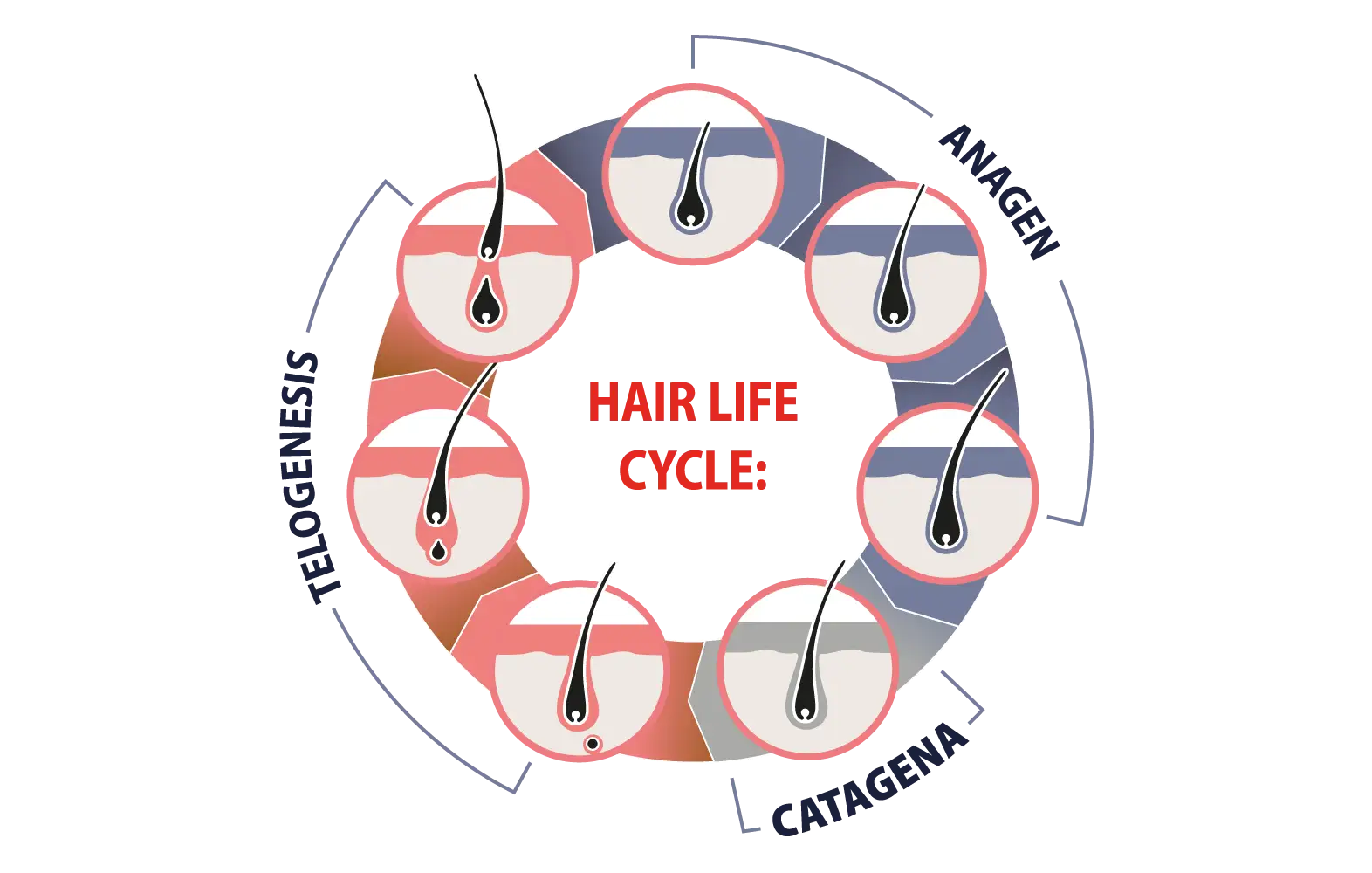Hair Loss
Thinner strands. A smaller ponytail. A scalp that suddenly feels more visible. Hair loss can happen gradually, but its impact is immediate—often signaling changes within your body that deserve attention.
At Biohackr Health in San Francisco and Palo Alto, we approach hair loss as both a physical and biological process. Our physician-led team investigates the hormonal, nutritional, and metabolic factors that influence hair growth, helping you understand why it’s happening—and what you can do about it.

What Causes Hair Loss?
Hair loss (alopecia) can stem from multiple overlapping factors, which is why a one-size-fits-all approach rarely works. At Biohackr Health, we begin with a comprehensive evaluation to determine which biological, environmental, and lifestyle influences are contributing to your specific pattern.
Common causes include:
- Genetic predisposition (androgenetic alopecia): Hair follicles become sensitive to dihydrotestosterone (DHT), leading to miniaturization and thinner strands.
- Hormonal changes: Menopause, thyroid dysfunction, pregnancy, and PCOS can all trigger or accelerate shedding.1
- Nutrient deficiencies: Low ferritin, vitamin D, zinc, copper, and B12 can shorten the hair growth cycle or cause diffuse thinning.2
- Stress and illness: Both chronic and acute stress can push large numbers of follicles into the telogen (resting) phase, a condition called telogen effluvium.3
- Rapid weight loss or GLP-1 use: Sudden metabolic shifts can disrupt protein and nutrient supply to follicles.
- Autoimmune and inflammatory conditions: Alopecia areata and other immune-mediated conditions may attack follicles directly.
- Environmental or chemical factors: Harsh chemical treatments, heat styling, or traction hairstyles can cause breakage and scarring alopecia over time.

Tip: Early evaluation is key. Once follicles remain dormant too long, they lose regenerative potential.
The Hair Growth Cycle Explained
Understanding hair loss begins with understanding how hair grows. Each strand follows a repeating life cycle that includes three main phases:
Anagen (Growth Phase):
This is the active stage where hair follicles produce new hair cells. It lasts 2–7 years and determines your maximum hair length. Most scalp hairs (85–90%) are in this phase at any given time.
Catagen (Transition Phase):
A brief 2–3 week phase where growth slows and the follicle detaches from its blood supply.
Telogen (Resting Phase):
Lasting about 2–4 months, this is when old hairs rest before naturally shedding to make way for new growth. Around 50–150 hairs typically shed per day during this phase.
Disruptions in the Cycle:
Conditions such as androgenetic alopecia shorten the anagen phase and prolong telogen, leading to thinner, weaker hair. Stress, nutrient deficiency, or hormonal imbalance can also trigger an early shift into telogen, causing diffuse shedding known as telogen effluvium.

The Emotional and Social Impact of Hair Loss
Hair loss can deeply affect confidence, relationships, and self-image. Studies show that up to 75% of people experiencing alopecia report decreased self-esteem and heightened anxiety.4 Women, in particular, often experience significant psychological distress with visible hair loss, reporting feelings of social withdrawal and reduced quality of life.5
At Biohackr Health, we approach every case with empathy. Our team acknowledges the emotional weight of hair loss and ensures that each consultation is as supportive as it is clinical. You’ll never feel rushed, dismissed, or “sold to”—only heard and guided.
Hair Loss Treatments at Biohackr Health
While this page focuses on understanding hair loss, Biohackr Health offers comprehensive, physician-led treatments that combine regenerative medicine with hormonal and nutritional optimization.
Our Evidence-Based Approach Includes:
Root-Cause Testing:
Root-Cause Testing: Blood panels through Access Labs identify thyroid issues, hormone imbalances, nutrient deficiencies, and autoimmune factors contributing to hair loss.

Regenerative Therapies:
Medical microneedling with Age Zero Exosomes, PRF injections, and topical Minoxidil—all supported by peer-reviewed data demonstrating improved hair density and follicle activity6,7,8

Hormone Optimization:
For patients with low estrogen, testosterone, or thyroid function, Bioidentical Hormone Replacement Therapy (BHRT) may restore equilibrium and reawaken dormant follicles.

Nutritional & IV Support:
Customized IV therapies, including Fit & Toned or Beauty IV, deliver essential micronutrients to promote healthy hair and scalp circulation.

Daily Support:
Physician-formulated Biohackr Hair GROW+ supplement combines biotin, zinc, ashwagandha, saw palmetto, and resveratrol to reinforce hair strength and reduce shedding.
For an in-depth look at our treatment options, visit our Hair Loss Treatment page.

The Biology Behind Regrowth: Why Early Intervention Matters
Hair restoration success depends largely on timing. Once follicles shrink and fibrose, regrowth becomes more difficult. Research shows that treatments such as microneedling, PRF, and exosome therapy can significantly improve hair density and caliber—especially in the early stages of androgenetic alopecia.9,10,
Combination therapies tend to outperform single modalities, reinforcing the Biohackr philosophy that regenerative medicine works best when science meets systems biology.
Learn More from Dr. Greenberg
Every Biohackr blog post on hair health and restoration is written by Dr. Lauren Greenberg, a Board-Certified Plastic Surgeon and regenerative medicine specialist. Her articles translate complex research into practical insights—covering topics like hormonal hair loss, microneedling, exosomes, and the science of regrowth.This science and data driven approach is what drives our clinical recommendations.
Explore evidence-based strategies, see what current studies reveal, and discover how regenerative medicine is reshaping the future of hair restoration.

Reclaim Confidence
Starting with a Conversation
At Biohackr Health, our team combines compassionate care with advanced regenerative science to help patients across San Francisco, Palo Alto, and the Bay Area restore confidence and vitality from the inside out.
Frequently Asked Questions About Hair Loss

How much hair loss is normal?
Losing 50–150 hairs per day is typical. Sudden increases in shedding or a widening part may indicate an underlying imbalance.
Can stress really cause hair loss?
Yes. Telogen effluvium—a temporary shedding pattern—often appears 2–3 months after a major stressor, illness, or surgery.
Do men and women lose hair differently?
Generally, yes. Men often experience receding hairlines or crown thinning, while women see diffuse thinning across the scalp.
Is hair loss reversible?
It depends on the cause. Many types of hair loss—such as telogen effluvium, thyroid-related shedding, or early androgenetic alopecia—are reversible with proper treatment. Scarring alopecia, however, is typically permanent.
When should I see a professional?
If your shedding lasts more than three months or you notice visible scalp changes, schedule a consultation. Early intervention offers the best outcomes.
Sources
Hasan R, Juma H, Eid FA, Alaswad HA, Ali WM, Aladraj FJ. Effects of Hormones and Endocrine Disorders on Hair Growth. Cureus. 2022 Dec 20;14(12):e32726. doi: 10.7759/cureus.32726. PMID: 36578854; PMCID: PMC9788837. Available: https://pmc.ncbi.nlm.nih.gov/articles/PMC9788837/.f Accessed November 12, 2025.
Almohanna HM, Ahmed AA, Tsatalis JP, Tosti A. The Role of Vitamins and Minerals in Hair Loss: A Review. Dermatol Ther (Heidelb). 2019 Mar;9(1):51-70. doi: 10.1007/s13555-018-0278-6. Epub 2018 Dec 13. PMID: 30547302; PMCID: PMC6380979. Available: https://pubmed.ncbi.nlm.nih.gov/30547302/. Accessed November 12, 2025.
Malkud S. Telogen Effluvium: A Review. J Clin Diagn Res. 2015 Sep;9(9):WE01-3. doi: 10.7860/JCDR/2015/15219.6492. Epub 2015 Sep 1. PMID: 26500992; PMCID: PMC4606321. Available: https://pmc.ncbi.nlm.nih.gov/articles/PMC4606321/. Accessed November 12, 2025.
Aukerman EL, Jafferany M. The psychological consequences of androgenetic alopecia: A systematic review. J Cosmet Dermatol. 2023 Jan;22(1):89-95. doi: 10.1111/jocd.14983. Epub 2022 Apr 25. PMID: 35403805; PMCID: PMC10084176. Available: https://pmc.ncbi.nlm.nih.gov/articles/PMC10084176/. Accessed November 12, 2025.
Dhami L. Psychology of Hair Loss Patients and Importance of Counseling. Indian J Plast Surg. 2021 Dec 31;54(4):411-415. doi: 10.1055/s-0041-1741037. PMID: 34984078; PMCID: PMC8719979. Available: https://pmc.ncbi.nlm.nih.gov/articles/PMC8719979/. Accessed November 12, 2025.
Schiavone, Giovanni MD*; Paradisi, Andrea MD, PhD†; Ricci, Francesco MD‡; Abeni, Damiano MD, MPH§. Injectable Platelet-, Leukocyte-, and Fibrin-Rich Plasma (iL-PRF) in the Management of Androgenetic Alopecia. Dermatologic Surgery 44(9):p 1183-1190, September 2018. | DOI: 10.1097/DSS.0000000000001584. Available: https://journals.lww.com/dermatologicsurgery/abstract/2018/09000/injectable_platelet_,_leukocyte_,_and_fibrin_rich.4.aspx. Accessed November 12, 2025.
Suchonwanit P, Thammarucha S, Leerunyakul K. Minoxidil and its use in hair disorders: a review. Drug Des Devel Ther. 2019 Aug 9;13:2777-2786. doi: 10.2147/DDDT.S214907. Erratum in: Drug Des Devel Ther. 2020 Feb 10;14:575. doi: 10.2147/DDDT.S247601. PMID: 31496654; PMCID: PMC6691938. Available: https://pmc.ncbi.nlm.nih.gov/articles/PMC6691938/. Accessed November 12, 2025.
Dhurat R, Sukesh M, Avhad G, Dandale A, Pal A, Pund P. A randomized evaluator blinded study of effect of microneedling in androgenetic alopecia: a pilot study. Int J Trichology. 2013 Jan;5(1):6-11. doi: 10.4103/0974-7753.114700. PMID: 23960389; PMCID: PMC3746236. Available: Accessed November 12, 2025.
Schiavone, Giovanni MD*; Paradisi, Andrea MD, PhD†; Ricci, Francesco MD‡; Abeni, Damiano MD, MPH§. Injectable Platelet-, Leukocyte-, and Fibrin-Rich Plasma (iL-PRF) in the Management of Androgenetic Alopecia. Dermatologic Surgery 44(9):p 1183-1190, September 2018. | DOI: 10.1097/DSS.0000000000001584. Available: https://journals.lww.com/dermatologicsurgery/abstract/2018/09000/injectable_platelet_,_leukocyte_,_and_fibrin_rich.4.aspx. Accessed November 12, 2025.